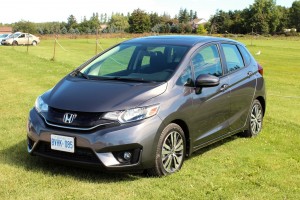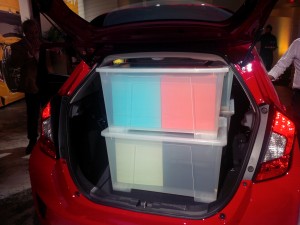 The sub-compact category is one that has become increasingly competitive and crowded over the years. The move towards more fuel efficient vehicles has created a surge in both all-new and newly designed entrants from virtually all automakers.
The sub-compact category is one that has become increasingly competitive and crowded over the years. The move towards more fuel efficient vehicles has created a surge in both all-new and newly designed entrants from virtually all automakers.
Since 2006, Honda in North America has relied on it’s Fit sub-compact, which replaced the Civic Hatchback to duke it out against other competitors such as the Hyundai Accent, Ford Fiesta, Nissan Versa Note and Toyota Yaris in this category. As other manufacturers released all new sub-compacts, it was time for Honda to do the same, and a 2nd generation Honda Fit is now about to be released for the 2015 model year.
Prior to it’s mid-September launch date in Canada, journalists including myself were recently given a chance to get up close with the new 2015 Honda Fit and take it out for a First Drive in Toronto.
Compared to its predecessor, the 2015 Fit is shorter in overall length by 41 mm, yet offers a longer wheelbase and is 8 mm wider. Due to a reconfiguration of the fuel tanks location, there have been some substantial interior efficiency improvements to the cabin. Passenger volume has been increased by 139 cubic litres and rear leg room has been increased by 122 mm when compared to the previous model Fit. Each of these figures according to Honda are class leading.
Quite impressive is not only the total amount of cargo space inside the Fit, but also the various configurations available inside. Total interior cargo volume is now a whopping 1492 Litres (just under 53 cubic feet). Honda has also created titles for 4 distinct seating and cargo configurations – Utility, Tall, Long and Refresh. Each has the capability to accommodate a variety of items that one wouldn’t always expect to be able to fit into a sub-compact. Refresh Mode is totally unique in that it allows the front passenger seat to fully lay flat, similar to a business-class airline seat. It nestles nicely against the rear seat with the end result being a seating configuration not too unlike a chez-lounge chair in your backyard. While not totally functional in transit, it provides an interesting option for times when the vehicle is parked at a rest stop or similar.
Powering the 2015 Honda Fit is a new 1.5L direct injected DOHC i-VTEC engine, that utilizes Honda’s Earth Dreams technology. It puts out 130 hp, which is an increase of 11% from the previous model and 114 lb-ft of torque, representing an increase of 7.5%. Honda offers both a CVT and a 6-speed manual transmission in all trim levels for the 2015 Fit.
Fuel efficiency has also improved over the previous model. Using the new 5-cycle testing methods, Honda posts that the CVT produces a combined fuel efficiency rating of 6.4 L/100 KM’s, while the manual transmission comes in at 7.3 L/100 KM’s combined. Honda states these numbers are a 16% improvement over the previous Fit.
During my initial Enviro Dad Test Drive, the fuel results achieved were actually better than posted…in fact substantially better. My driving partner and I drove the roughly 120 KM drive route using a CVT transmission. The route included a mix of city, highway and suburban driving and we finished off with a rating of 5.4 L/100 KM. Noteworthy in this result was the fact that we were driving with the A/C ON and the Econ button OFF. We drove with the normal flow of traffic and didn’t attempt to hyper-mile at any point. Roads were generally open and conditions were ideal, so that would play into matters somewhat, but the results even managed to surprise the Product Planners at Honda when we finished our drive route. These numbers were of course done only during one driving day, and results would likely be different over a prolonged week-long test. I’ve booked a week with the new Fit for early October and I’ll be eager to see what the results will be after a prolonged test, but suffice to say so far the numbers for fuel efficiency are very impressive.
Aside from fuel efficiency, I found the drive in the new Fit to be enjoyable for the most part. The sightlines provided out the front are significant thanks to what appears to be a massive front windshield and aided by glass inserts into the front A-pillars. Seating is generally comfortable and most required controls are easy to reach and placed appropriately.
Acceleration in the CVT was quite even and responsive. It felt better than many other CVT’s I’ve driven. Rapid acceleration attempts were relatively painless and overall handling met the expectations of what a sub-compact economy vehicle should offer.
The only part of the interior that I did not like was the 7-inch Display Audio found in our EX model trim. The flat design with electrostatic touch panel was difficult to use, especially the sliding volume control. I’m someone who very much prefers a more tactile feel with controls like this (which also explains why I stick with a BlackBerry), and both my drive partner and I expressed our frustration with the lack of buttons on this unit. There is a 5-inch unit that comes on the base DX model that includes knobs, and this may be one situations where the base model is preferable.
Overall, my first impressions of the 2015 Fit are quite positive. It’s more spacious than it appears, more fuel efficient than I expected and is likely a car that will give others in its class a lot to worry about.
Canadian pricing for the 2015 Honda Fit begins at $14,995 for a DX with 6-speed manual, right up to $22,595 for an EX-L Navi with CVT.
Honda Canada is targeting annual sales of 14,000 units for the new Fit, and based upon my initial observations and experience driving it, I believe it will be an easy benchmark to achieve.




Leave a Reply